|
Lesson
4
A Time of Strife
|
| |
The United States Army built two new forts in what is now South
Dakota. Fort Sully was on the Missouri River. Fort Wadsworth was
near Lake Traverse. The settlers wanted the army there to protect
them. A new trail across Indian lands soon opened. It was called
the Bozeman Trail. This road led even more people to the West.
Prospectors went over it to the gold
fields of Montana.
|
|
Many Indians now felt that their way of life was at stake. They
feared white settlements would eat away at their lands. They were
afraid that they would be left with nothing. Red Cloud, was
an Oglala Lakota leader. He warned the United States government of
opposition. He said that there
would be war if the Bozeman Trail opened. This was called Red
Cloud’s War. Oglala warriors attacked wagons along the trail.
The army sent troops, but a large group of Oglalas and Cheyennes
defeated them. Crazy Horse was a leader in this battle. The
Oglalas and Cheyennes killed more soldiers. Soon the United States
wanted peace. The government called a treaty
council. The year was 1868.
|
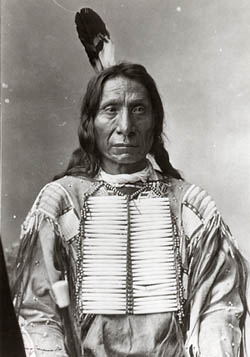
Photo courtesy of South Dakota State
Historical Society
|
|

Photo courtesy of South Dakota State
Historical Society
|
The treaty made at Fort Laramie ended Red Cloud’s War. The
Indians had won. The Bozeman Trail was closed, but the tribes had to give up some land. They would be paid for it in money
and supplies. They would have to live on reservations. The treaty
set up the Great Sioux Reservation for the Lakotas. This was all
the land west of the Missouri River to what is now the border of
Wyoming. The Black Hills were part of it. The hills had spiritual
meaning for the Lakotas and Cheyennes. This treaty made it
possible for the United States to buy more of their land.
Three-quarters of the adult men in the tribes had to agree to any
sale.
|
|
Agents of the
United States could still enter the reservation even though
settlers could not. The army sent Lieutenant Colonel George A. Custer to
explore the Black Hills. No one in the United States knew much about
them. It was 1874. Custer brought one thousand soldiers and fifty
Indian scouts. He took along scientists, newspapermen, a
photographer, and even a band. Two men found gold in French Creek.
The newspapers let the rest of the country know about it.
|
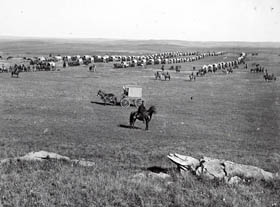
Photo courtesy of South Dakota State
Historical Society
|
|
|
|
|
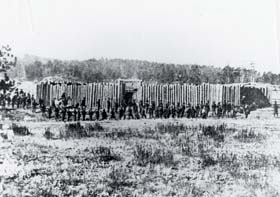
Photo courtesy of South Dakota State
Historical Society
|
Just a few
months later, the Gordon party left Sioux City, Iowa. These
twenty-eight people slipped into the Black Hills illegally, or
against the law. They spent a hard
winter in a log
stockade on
French Creek. They found only forty dollars worth of gold. In the
spring, the army forced them to leave. But prospectors poured into
the Black Hills without permission. Perhaps eight hundred slipped past the army the
next year.
|
|
|
|
|
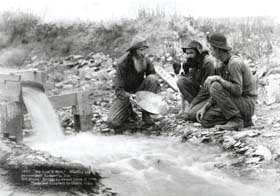
Photo courtesy of South Dakota State
Historical Society
|
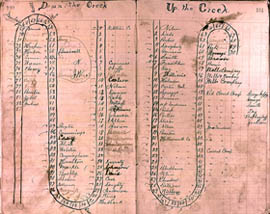
Photo courtesy of South Dakota State
Historical Society
|
The United
States tried to buy the Black Hills from the Lakotas, but they
refused. So the army withdrew from the Black Hills. More prospectors
rushed in. The Black Hills gold rush had begun. Soon thousands of people were there. They were panning or
digging for gold. Deadwood Gulch was the center of the richest
strikes. People from all over moved there. A group of Chinese
people migrated there. Colorful people like Wild Bill Hickok,
Calamity Jane, and Poker Alice walked the streets of Deadwood.
Hotels, dance halls, saloons, laundries, and banks sprang up almost
overnight.
|
|
The army told
the Lakotas to go to their agencies. Each Lakota group had an agency
on the reservation. They met with United States agents there. Many
groups would not go. The army planned to force them to go.
Lakotas and Cheyennes waited for the army to come. They camped on
the Little Bighorn River in what is now Montana. The Seventh Cavalry
attacked the camp. George A. Custer led the United States troops.
Crazy Horse, Sitting Bull, and Gall were the Indian
leaders. Custer and all his men were killed. This is known as the
Battle of the Little Bighorn, or Greasy Grass as Lakotas call it. It took place in June
1876 near what is now Hardin, Montana.
|
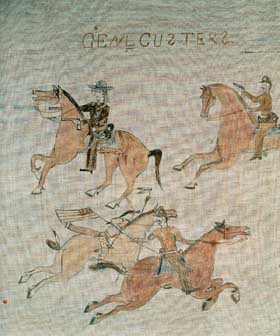
Photo courtesy of South Dakota State
Historical Society
|
|
|
But the
Indians had little to celebrate. The buffalo were almost gone. The
army was angry. Soldiers now moved onto the reservation. They took
guns and horses away from the Indians. Soon Crazy Horse and his
people went in to their agency. Sitting Bull and Gall and their
people fled to Canada.
The United
States Congress acted even quicker than the army. It passed a bill
that cut off payment to the Lakota people unless they gave up the
Black Hills. Some leaders agreed; their people were starving. But
less than three-quarters of the adult Lakota men approved the sale.
This was not what the Fort Laramie Treaty had said. The Indians now
lived on the reservation. A new and hard way of life had started for
them.
|
|
|
| Vocabulary |
|
| council (n.), a group of people brought together to
negotiate or decide something
opposition (n.), an unfriendly attitude toward something
|
prospectors (n.), people who look for gold, oil, or
mineral deposits
stockade (n.), a fort made of log posts
|
|